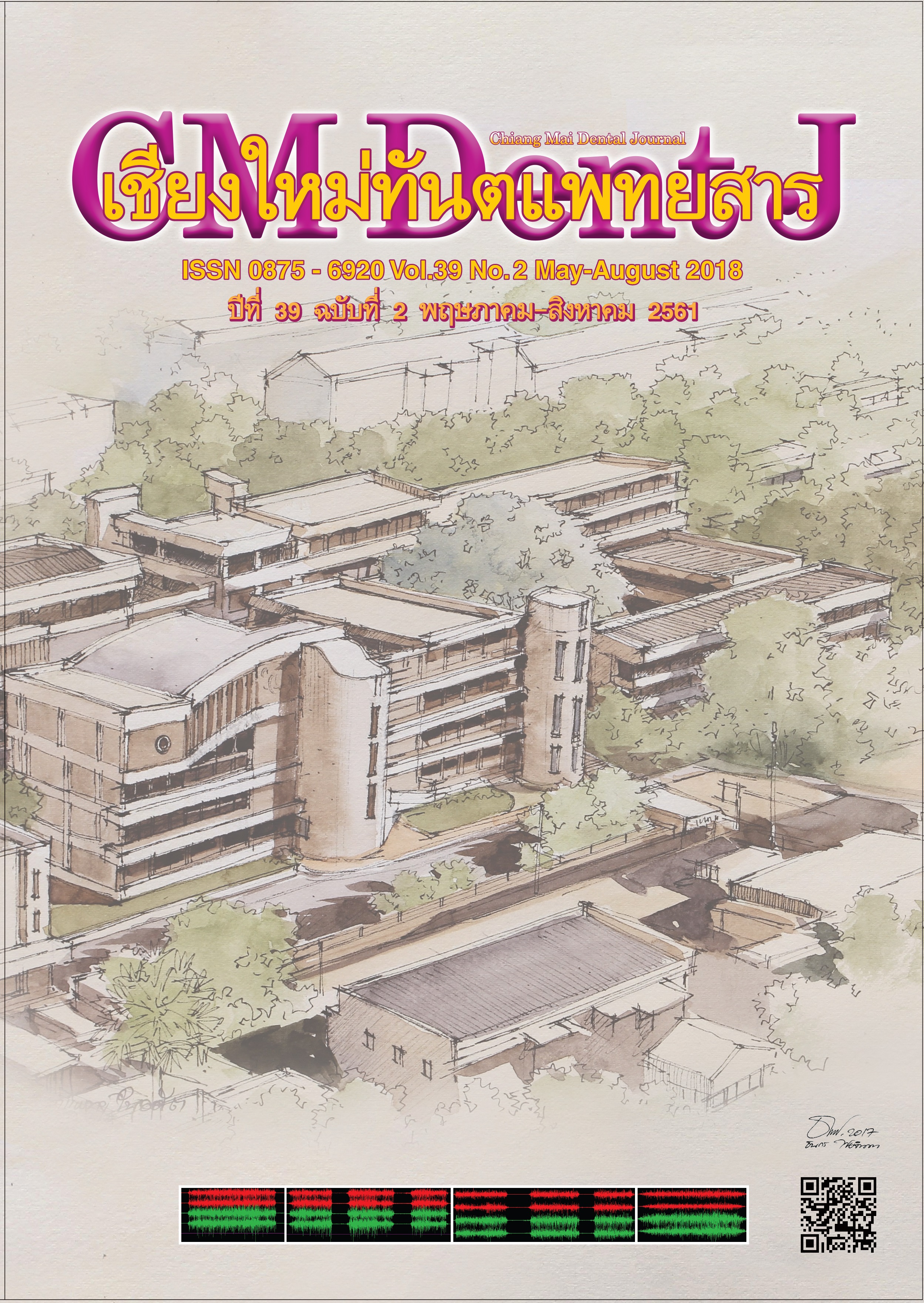Masseter and Temporalis Muscle Activity in Patients with Class III Skeletal Relationships
Main Article Content
Abstract
This study aimed to evaluate the masseter and temporalis muscle activity in patients with Class III skeletal relationships, using surface electromyography (SEMG). The study group consisted of 30 subjects with Class III skeletal relationships, aged 18-34 years (mean 22.4 years) and 30 subjects with Class I skeletal relationships aged 18-35 years (mean 22.6 years). All subjects had normal vertical configuration, no temporomandibular disease and no previous orthodontic treatment. The SEMG activity was recorded from the masseter and temporalis muscles while in maximum clenching on cotton rolls and in maximum voluntary contraction (MVC). The values for maximum clenching on cotton rolls were used to standardize and normalize all MVC data. Then, the percentage overlapping coefficient (POC) index and the torque coefficient (TC) index were calculated from the standardized MVC data. The POC and TC indices from both groups were compared using the two-sample t-test. The masseter POC in the patients with Class III skeletal relationships was less than that in those with Class I skeletal relationships with statistical significance (p<0.01). The temporalis POC and TC were not different between groups. This study shows that patients with Class III skeletal relationships have lower symmetry in the masseter muscle function than do patients with Class I skeletal relationships.
Article Details
References
Proffit WR. The etiology of orthodontic problems. In: Proffit WR, Fields Jr HW, Sarver DM, ed: Contemporary orthodontics. 5th ed. Canada: Elsevier; 2014: 114-149.
Moss JP. Function-fact or fiction? Am J Orthod. 1975; 67: 625-646.
Shiratsuchi Y, Kouno K, Tashiro H. Evaluation of masticatory function following orthognathic surgical correction of mandibular prognathism. J Craniomaxillofac Surg. 1991; 19: 299-303.
Lowe AA. Correlations between orofacial muscle activity and craniofacial morphology in a sample of control and anterior open-bite subjects. Am J Orthod. 1980; 78: 89-98.
Liebman FM, Cosenza F. An evaluation of electromyography in the study of the etiology of malocclusion. J Pros Dent. 1960; 10: 1065-1077.
Youssef RE, Throckmorton GS, Ellis E, 3rd, Sinn DP. Comparison of habitual masticatory cycles and muscle activity before and after orthognathic surgery. J Oral Maxillofac Surg. 1997; 55: 699-708.
Iwase M, Sugimori M, Kurachi Y, Nagumo M. Changes in bite force and occlusal contacts in patients treated for mandibular prognathism by orthognathic surgery. J Oral Maxillofac Surg. 1998; 56: 850-856.
Wang D, Fu H, Zeng R, Yang X. Changes of mandibular movement tracings after the correction of mandibular protrusion by bilateral sagittal split ramus osteotomy. J Oral Maxillofac Surg. 2009; 67: 2238-2244.
Castroflorio T, Bracco P, Farina D. Surface electromyography in the assessment of jaw elevator muscles. J Oral Rehabil. 2008; 35: 638-645.
Iyer M, Valiathan A. Electromyography and its application in orthodontics. Curr Sci. 2001; 80: 503-506.
Ko EW, Huang CS, Lo LJ, Chen YR. Alteration of masticatory electromyographic activity and stability of orthognathic surgery in patients with skeletal class III malocclusion. J Oral Maxillofac Surg. 2013; 71: 1249-1260.
Ferrario VF, Sforza C, Colombo A, Ciusa V. An electromyographic investigation of masticatory muscles symmetry in normo-occlusion subjects. J Oral Rehabil. 2000; 27: 33-40.
Proffit WR, Turvey TA, Fields HW, Phillips C. The effect of orthognathic surgery on occlusal force. J oral maxillofac surg. 1989; 47: 457-463.
Cha BK, Kim CH, Baek SH. Skeletal sagittal and vertical facial types and electromyographic activity of the masticatory muscle. Angle Orthod. 2007; 77: 463-470.
Di Palma E, Gasparini G, Pelo S, Pelo S, artaglia GM, Sforza C. Activities of masticatory muscles in patients before orthognathic surgery. J Craniofac Surg. 2010; 21: 724-726.
Klasser GD, Okeson JP. The clinical usefulness of surface electromyography in the diagnosis and treatment of temporomandibular disorders. J Am Dent Assoc. 2006; 137: 763-771.
Cecere F, Ruf S, Pancherz H. Is quantitative electromyography reliable? J orofacial pain. 1996;10: 38-47.
Moss JP, Chalmers CP. An electromyographic investigation of patients with a normal jaw relationship and a Class III jaw relationship. Am J Orthod. 1974; 66: 538-556.
Ahlgren J, Sonesson B, Blitz M. An electromyographic analysis of the temporalis function of normal occlusion. Am J Orthod. 1985; 87: 230-239.
Ferrario VF, Sforza C, Miani A, Jr., D'Addona A, Barbini E. Electromyographic activity of human masticatory muscles in normal young people. Statistical evaluation of reference values for clinical applications. J Oral Rehabil. 1993; 20: 271-280.
Ahlgren J. Form and function of Angle Class 3 malocclusion. A cephalometric and electromyographic study. Rep Congr Eur Orthod Soc. 1970: 77-88.
Moreno I, Sanchez T, Ardizone I, Aneiros F, Celemin A. Electromyographic comparisons between clenching, swallowing and chewing in jaw muscles with varying occlusal parameters. Med Oral Patol Oral Cir Bucal. 2008; 13: E207-E213.
Tate GS, Throckmorton GS, Ellis E, Sinn DP. Masticatory performance, muscle activity, and occlusal force in preorthognathic surgery patients. J oral maxillofac surg. 1994; 52: 476-481.
Dong Y, Wang X, Wang M, Widmalm S. Asymmetric muscle function in patients with developmental mandibular asymmetry. J oral rehabil. 2008; 35: 27-36.
Haraguchi S, Takada K, Yasuda Y. Facial asymmetry in subjects with skeletal Class III deformity. Angle orthodontist. 2002; 72: 28-35.
Alarcón JA, Martín C, Palma JC. Effect of unilateral posterior crossbite on the electromyographic activity of human masticatory muscles. Am J Orthod Dentofacial Orthop. 2000; 118: 328-334.
Alarcón JA, Martín C, Palma JC, Menéndez-Núñez M. Activity of jaw muscles in unilateral cross-bite without mandibular shift. Arch oral biol. 2009; 54: 108-114.


